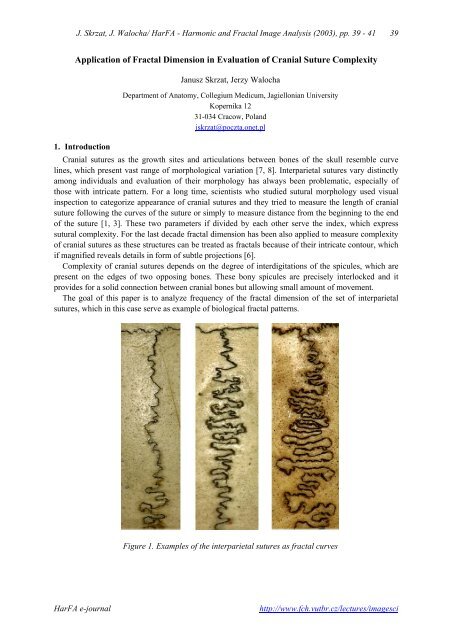Application of Fractal Dimension in Evaluation of Cranial Suture ...
Application of Fractal Dimension in Evaluation of Cranial Suture ...
Application of Fractal Dimension in Evaluation of Cranial Suture ...
You also want an ePaper? Increase the reach of your titles
YUMPU automatically turns print PDFs into web optimized ePapers that Google loves.
J. Skrzat, J. Walocha/ HarFA - Harmonic and <strong>Fractal</strong> Image Analysis (2003), pp. 39 - 41<br />
<strong>Application</strong> <strong>of</strong> <strong>Fractal</strong> <strong>Dimension</strong> <strong>in</strong> <strong>Evaluation</strong> <strong>of</strong> <strong>Cranial</strong> <strong>Suture</strong> Complexity<br />
Janusz Skrzat, Jerzy Walocha<br />
Department <strong>of</strong> Anatomy, Collegium Medicum, Jagiellonian University<br />
Kopernika 12<br />
31-034 Cracow, Poland<br />
jskrzat@poczta.onet.pl<br />
1. Introduction<br />
<strong>Cranial</strong> sutures as the growth sites and articulations between bones <strong>of</strong> the skull resemble curve<br />
l<strong>in</strong>es, which present vast range <strong>of</strong> morphological variation [7, 8]. Interparietal sutures vary dist<strong>in</strong>ctly<br />
among <strong>in</strong>dividuals and evaluation <strong>of</strong> their morphology has always been problematic, especially <strong>of</strong><br />
those with <strong>in</strong>tricate pattern. For a long time, scientists who studied sutural morphology used visual<br />
<strong>in</strong>spection to categorize appearance <strong>of</strong> cranial sutures and they tried to measure the length <strong>of</strong> cranial<br />
suture follow<strong>in</strong>g the curves <strong>of</strong> the suture or simply to measure distance from the beg<strong>in</strong>n<strong>in</strong>g to the end<br />
<strong>of</strong> the suture [1, 3]. These two parameters if divided by each other serve the <strong>in</strong>dex, which express<br />
sutural complexity. For the last decade fractal dimension has been also applied to measure complexity<br />
<strong>of</strong> cranial sutures as these structures can be treated as fractals because <strong>of</strong> their <strong>in</strong>tricate contour, which<br />
if magnified reveals details <strong>in</strong> form <strong>of</strong> subtle projections [6].<br />
Complexity <strong>of</strong> cranial sutures depends on the degree <strong>of</strong> <strong>in</strong>terdigitations <strong>of</strong> the spicules, which are<br />
present on the edges <strong>of</strong> two oppos<strong>in</strong>g bones. These bony spicules are precisely <strong>in</strong>terlocked and it<br />
provides for a solid connection between cranial bones but allow<strong>in</strong>g small amount <strong>of</strong> movement.<br />
The goal <strong>of</strong> this paper is to analyze frequency <strong>of</strong> the fractal dimension <strong>of</strong> the set <strong>of</strong> <strong>in</strong>terparietal<br />
sutures, which <strong>in</strong> this case serve as example <strong>of</strong> biological fractal patterns.<br />
Figure 1. Examples <strong>of</strong> the <strong>in</strong>terparietal sutures as fractal curves<br />
HarFA e-journal http://www.fch.vutbr.cz/lectures/imagesci<br />
39
40<br />
J. Skrzat, J. Walocha/ HarFA - Harmonic and <strong>Fractal</strong> Image Analysis (2003), pp. 39 - 41<br />
2. Material and method<br />
We analyzed complexity <strong>of</strong> 40 <strong>in</strong>terparietal sutures <strong>of</strong> the external surface <strong>of</strong> the cranial vault. The<br />
specimens were taken from the skulls which belong to the collection <strong>of</strong> the Anatomical Museum <strong>of</strong> the<br />
Jagiellonian University <strong>in</strong> Cracow. The images <strong>of</strong> these sutures were acquired <strong>in</strong> the follow<strong>in</strong>g<br />
manner. A transparent tape had been placed on the external surface <strong>of</strong> the skull along the analyzed<br />
suture and its contour was traced with a marker that drew a th<strong>in</strong> l<strong>in</strong>e. Traced silhouettes <strong>of</strong> the sutures<br />
were scanned with a flat bat scanner and the digitized images were skeletonized to obta<strong>in</strong> a l<strong>in</strong>e wide<br />
<strong>of</strong> 1 pixel. Such obta<strong>in</strong>ed images <strong>of</strong> cranial sutures silhouettes were subjected to the HarFa s<strong>of</strong>tware,<br />
which measured fractal dimension <strong>of</strong> the sutural images us<strong>in</strong>g the box-count<strong>in</strong>g algorithm.<br />
3. Results<br />
The estimated fractal dimension <strong>of</strong> the contours <strong>of</strong> the <strong>in</strong>terparietal sutures ranges from 1.1 to 1.59<br />
and mean value equals 1.34 (std dev. = 0.114). Frequency <strong>of</strong> the fractal dimension <strong>in</strong> the analyzed<br />
sample is presented on Figure 2.<br />
No <strong>of</strong> observations<br />
20<br />
18<br />
16<br />
14<br />
12<br />
10<br />
8<br />
6<br />
4<br />
2<br />
0<br />
1,0 1,1 1,2 1,3 1,4 1,5 1,6<br />
Upper Boundaries (x
J. Skrzat, J. Walocha/ HarFA - Harmonic and <strong>Fractal</strong> Image Analysis (2003), pp. 39 - 41<br />
regarded as considerably complicated [9]. Moreover fractal dimension becomes a helpful parameter<br />
which can be easily compared or correlated to other metrical characteristics <strong>of</strong> the skull or selected<br />
cranial bone. Sutural complexity is strictly related to amount <strong>of</strong> <strong>in</strong>terdigitations <strong>of</strong> the edges <strong>of</strong> the<br />
l<strong>in</strong>ked bones. As it was reported by Jaslow <strong>in</strong>crease energy absorption was correlated with <strong>in</strong>creased<br />
sutural <strong>in</strong>terdigitations [5]. The sutures between cranial bones provide for not only <strong>in</strong>terstitial growth<br />
<strong>of</strong> the cranium, but they also alter the transmission <strong>of</strong> stress and stra<strong>in</strong> through the skull [4].<br />
Measurements <strong>of</strong> cranial suture complexity seem to be important <strong>in</strong> a case <strong>of</strong> considerations <strong>of</strong><br />
mechanical properties <strong>of</strong> the articulations between cranial bones, their function and stability <strong>in</strong> the<br />
entire skull. Because <strong>of</strong> important role which sutures play <strong>in</strong> the skull a thorough <strong>in</strong>vestigation <strong>of</strong> these<br />
structures is essential for better understand<strong>in</strong>g functional aspects <strong>of</strong> the skull. We presume that fractal<br />
approach to cranial suture morphology may be crucial <strong>in</strong> mentioned problems.<br />
5. Literature<br />
1. Anton SC, Jaslow CR, Swartz SM. Sutural complexity <strong>in</strong> artificial deformed human (Homo<br />
sapiens) crania. J Morphol, 214: 321-332, 1992.<br />
2. Hartwig WC. <strong>Fractal</strong> analysis <strong>of</strong> sagittal suture morphology. J Morphol, 210: 289-298, 1991.<br />
3. Hauser G, Manzi G, Vienna A, De Stefano GF. Size and shape <strong>of</strong> human cranial sutures – a new<br />
scor<strong>in</strong>g method. Amer J Anat, 190 (3), 231-244, 1991<br />
4. Herr<strong>in</strong>g SW, Teng S. Stra<strong>in</strong> <strong>in</strong> the bra<strong>in</strong>case and its sutures dur<strong>in</strong>g function. Am J Phys Anthrop,<br />
112: 575-593, 2000.<br />
5. Jaslow CR. Mechanical properties <strong>of</strong> cranial sutures. J Biomech, 23(4): 313-321, 1990.<br />
6. Long CA, Long JE. <strong>Fractal</strong> dimensions <strong>of</strong> cranial sutures and waveforms. Acta Anat, 145 (3):<br />
201-206, 1992.<br />
7. Opperman LA. <strong>Cranial</strong> sutures as <strong>in</strong>tramembranous bone growth sites. Dev Dyn, 219:<br />
472-485, 2000.<br />
8. Persson M. The role <strong>of</strong> the sutures <strong>in</strong> normal and abnormal crani<strong>of</strong>acial growth. Acta<br />
Odontol Scand, 53:152-161, 1995.<br />
9. Skrzat J, Chmiel D, Usarz M. <strong>Fractal</strong> complexity as a new measure <strong>of</strong> the cranial suture<br />
complexity. Medical Review - Scripta Periodica, 3 (3): 418-422, 2000.<br />
HarFA e-journal http://www.fch.vutbr.cz/lectures/imagesci<br />
41
















